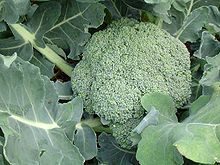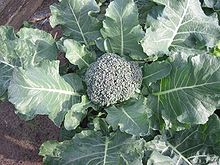broccoli
Broccoli or broccoli ( Brassica oleracea var. Italica Plenck ) ( Italian il broccolo from broccoli , "cabbage sprouts"), also called crumbled , asparagus , winter flower or sprout cabbage , is a vegetable from the cruciferous family that is closely related to cauliflower ( Brassicaceae).
description
It grows in a similar way to cauliflower, and like this one, the "florets" of the head consist of the not yet fully developed inflorescences, the flower buds, in contrast to cauliflower, are well developed and clearly recognizable. The head is usually of a deep green to blue-green color; purple, yellow and white varieties are rarer. Broccoli has a 14 to 15 week growing season .
Broccoli is harvested as soon as the middle flower is well developed and still closed. The still closed inflorescences are cut off with 10 to 15 centimeters long stalk and leaves. Further small flower heads develop from the side buds, which can be cut at a later point in time. The flower can be harvested and used alone as a flowering vegetable or complete with the sturdy stems. In order to increase the yield of broccoli, CMS hybrids are mostly grown today .
history
Originally from Asia Minor , broccoli was initially only known in Europe in Italy . Through Caterina de 'Medici it came to France in the 16th century and to England as "Italian asparagus" , only to be introduced to the United States by the US President Thomas Jefferson in the 18th century, initially as a test plant .
The main growing areas in Europe are the western Mediterranean countries, especially the area around Verona in Italy .
ingredients
Broccoli is particularly rich in minerals such as potassium , calcium , phosphorus , iron , zinc and sodium and vitamins such as B1 , B2 , B6 , E and especially ascorbic acid (vitamin C) and carotene (provitamin A).
It also contains numerous secondary plant substances ( flavonoids , glucosinolates and others). Glucosinolates in turn store various indoles and many isothiocyanates . Broccoli contains the following isothiocyanates: sulforaphane , 3-methylsulfinylpropyl isothiocyanate , 3-butenyl isothiocyanate, allyl isothiocyanate and 4-methylsulfinylbutyl isothiocyanate .
| 100 g broccoli contain: | ||||||
| Calorific value | ||||||
| kJ | kcal | water | fat | recoverable carbohydrates | Fiber | |
| raw | 117 | 28 | 90 g | 0.2 g | 2.7 g | 3.0 g |
| at all | 92 | 22nd | 22 g | 0.2 g | 2 g | 2.7 g (total) |
| Set elements | ||||||
| potassium | Calcium | magnesium | phosphorus | protein | iron | |
| raw | 373 mg | 105 mg | 24 mg | 65 mg | 3.5 g | 0.8 mg |
| at all | 324 mg | 87 mg | x mg | 65 mg | 2.8 g | |
| Vitamins | ||||||
| Vitamin A | vitamin C | Vitamin E. | ||||
| raw | 143 µg | 115 mg | 1.2 mg | |||
| at all | no | 90 mg | ? | |||
Use in the kitchen and preparation
Broccoli can be enjoyed raw or cooked. When cooking methods cooking, stewing, steaming, frying, blanching and cooking are possible in the microwave. Scientific studies have shown that the water-soluble nutrients such as vitamin C and minerals are largely retained during steam cooking, while they are dissolved in the cooking water when boiling in boiling water. The cooking time is between 6 and 10 minutes, depending on the individually desired sensory result: A longer cooking time leads to a softer product.
Not only the florets, but also the tender leaves and stems, which can be arranged like asparagus , are edible.
As a spice , freshly grated nutmeg , garlic and roasted pine nuts or almond leaves go well with broccoli in addition to salt .
Sprouts are also grown from the seeds, which can be eaten raw in salads or used as decorations on dishes.
storage
You can recognize fresh broccoli when you buy it by its strong color and closed flowers. It should be stored in a cool place, preferably in cling film in the vegetable drawer in the refrigerator. This way it lasts up to three days. If the broccoli is stored too warm, it will lose at least ten percent of its vitamin C content every day.
In the course of storage, enzymes are formed that lead to faster spoilage. As a countermeasure, broccoli can be blanched briefly and then frozen straight away. The enzymes are deactivated.
Other uses
The seeds are also used to make broccoli seed oil, which is used as a hair and face care product.
literature
- Richard Béliveau, Denis Gingras: Cancer cells don't like raspberries. Kösel, Munich 2007, ISBN 978-3-466-34502-1 .
Web links
Individual evidence
- ↑ Brassica oleracea var. Italica in the Integrated Taxonomic Information System (ITIS)
- ↑ Werner Rauh: Morphology of the useful plants. 2nd edition, 1950, Quelle and Meyer, Heidelberg / Wiesbaden 1994, ISBN 3-494-01228-8 (reprint).
- ↑ Roger Müller: Swiss vegetables from genetic laboratories: the consumer has no choice. In: srf.ch . September 2, 2014, accessed March 17, 2019 .
- ↑ German Research Institute for Food Chemistry (Ed.), Friedrich Senser (processing): Food table for practice. The little souci specialist herb. 4th edition. Wissenschaftliche Verlags-Gesellschaft, Stuttgart 2009, ISBN 978-3-8047-2541-6 .
- ↑ Broccoli in the Nestlé Nutrition Studio.
- ↑ E. Schlich, M. Schlich: Cooking methods for plant-based foods and their influence on micronutrients - Part 1. In: Aktuell Ernährlehre & Praxis, ErnahrungUmschau. (60) 8, 2013, pp. S31-S34.
- ↑ E. Schlich, M. Schlich: Cooking methods for plant-based foods and their influence on micronutrients - Part 2. In: Aktuell Ernährlehre & Praxis, ErnahrungUmschau. (60) 9, 2013, pp. S35-S38.
- ↑ Isabel Günther: Prepare broccoli delicious and vitamin-friendly - this is how it works. In: Springlane. February 22, 2017, accessed December 9, 2019 (German).
- ↑ a b A – Z of fruit and vegetable storage. In: bmnt.gv.at. Retrieved August 26, 2019 .
- ↑ Sabine Kirschner, Helmut Göppel: Handbook of vegetable oils. Param, 2014, ISBN 978-3-88755-714-0 .





